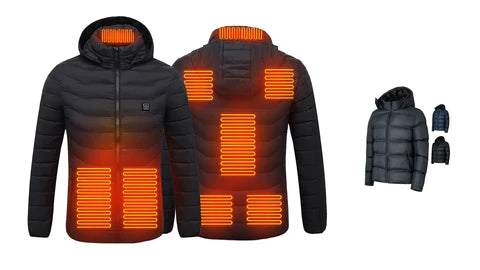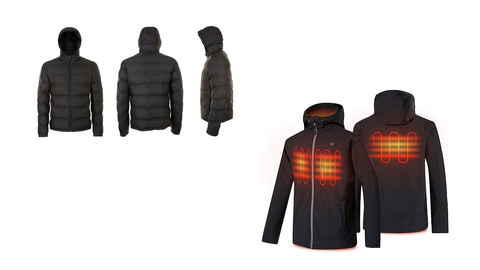Heated jackets offer active, on-demand warmth through integrated heating elements, providing customizable comfort. They excel in extreme cold conditions, offering consistent heat distribution. Traditional insulation jackets rely solely on passive insulation materials to trap body heat, lacking adjustable warmth. Heated jackets provide an innovative solution, ensuring optimal comfort and adaptability in varying weather conditions.
This article will keep you at the center of heated jackets vs. traditional jackets with an insulation layer, letting you decide which one suits you the best.
Understanding Heated Jackets
Heated Jacket & It’s Working
A heated jacket is a specialized type of outerwear that features built-in heating elements to provide warmth in cold weather. These jackets are typically battery-powered and use advanced heating technologies such as carbon fiber heating panels or micro-heating wires. The heating elements are strategically placed within the jacket, often targeting core body areas like the chest and back. When activated, the heating elements generate heat, which is then transferred to the wearer, providing warmth and comfort.
Various Heating Technologies
Far Infrared Heating: Far infrared heating technology uses special elements that emit far infrared radiation. FIR heat is absorbed by the body, promoting deep warmth. This type of heating is gentle, energy-efficient, and often associated with therapeutic benefits such as improved blood circulation and muscle relaxation.
Graphene Heating: Graphene heating technology utilizes graphene, a thin layer of carbon atoms with excellent conductivity properties. Graphene sheets or films are integrated into the jacket's fabric, generating heat quickly and evenly. Graphene heating offers efficient warmth and is known for its lightweight and flexible nature.
Key Benefits
Exceptional Warmth: Heated jackets provide active and adjustable warmth, allowing you to regulate your body temperature in cold weather. The integrated heating elements generate heat that can be adjusted to your desired level, ensuring you stay comfortably warm even in frigid temperatures.
Convenience and Ease of Use: Heated jackets are generally easy to use and operate. They often feature simple controls, such as buttons or dials, to adjust heat settings. Additionally, the battery-powered operation ensures that you can enjoy warmth without the need for external power sources.


Exploring Traditional Insulation
Traditional insulation jackets are designed to provide warmth and comfort by utilizing insulating materials. These jackets typically feature layers of insulation, such as down feathers, synthetic fibers, or wool, that trap heat and create a thermal barrier. The insulating materials work by minimizing heat transfer and retaining the body's natural warmth. Some common materials used in these jackets are:
Down: Down insulation is sourced from the soft feathers underneath the outer feathers of ducks or geese. It is known for its exceptional warmth-to-weight ratio, as the clusters of down trap air to create insulation.
Synthetic Fill: Synthetic insulation materials, such as polyester or PrimaLoft, are popular alternatives to down. These synthetic fibers mimic the insulating properties of down, offering warmth even when wet and often providing hypoallergenic qualities.
How A Traditional Insulation Jacket Retains Heat?
Insulation: The primary principle of traditional insulation jackets is insulation. The jackets use insulating materials, such as down feathers, synthetic fibers, or wool, which create a layer of trapped air. This layer acts as a barrier, preventing heat from escaping and cold air from penetrating, thus retaining body heat.
Loft: Loft refers to the ability of the insulation material to trap air. Traditional insulation jackets are designed with lofty materials that have a high loft-to-weight ratio. The trapped air within the insulation forms a layer of insulation, reducing heat loss by creating a thermal barrier.
Air Pockets: Insulation materials in traditional jackets are structured to create small air pockets. These air pockets help to retain warmth by trapping and holding air, which acts as an insulating layer. The air pockets prevent heat loss and create a buffer against cold temperatures.
Key Advantages
- Traditional insulation materials, especially high-quality down, provide exceptional warmth. They have a high warmth-to-weight ratio and efficiently trap and retain body heat, keeping you cozy in cold weather.
- Traditional insulation is known for its lightweight nature. It offers substantial warmth without adding excessive bulk or weight to the jacket, allowing for ease of movement and comfort.
Minor Disadvantages
- Traditional insulation, especially down, loses its insulating properties when wet. Moisture can cause the insulation to clump together, reducing its ability to retain warmth.
- If traditional insulation gets wet, it can take longer to dry compared to synthetic alternatives. This can be a disadvantage in wet or humid conditions where rapid drying is necessary to maintain warmth.
Comparing Warmth Factors
In this section, we’ll go through the comparison of warmth factors in traditional insulation vs. heated jackets.
Active vs. Passive Warmth
Heated jackets provide active warmth through integrated heating elements, allowing you to generate and control heat as needed. In contrast, traditional insulation jackets rely on passive insulation materials to trap and retain body heat.
Heated jackets offer the advantage of instant, on-demand heat, while traditional insulation jackets depend on your body heat to warm the insulated air pockets.
Customizable Heat Levels
Heated jackets offer adjustable heat settings, allowing you to customize the level of warmth according to your preference and the weather conditions. This versatility ensures optimal comfort and adaptability.
Traditional insulation jackets lack this feature, providing a consistent level of insulation without the ability to adjust the warmth level.
Heat Distribution
Heated jackets typically have strategically placed heating elements that provide even heat distribution, targeting core body areas such as the chest and back. This ensures a balanced warmth throughout the jacket.
Traditional insulation jackets distribute warmth based on body heat and can have variations in heat distribution depending on the quality and distribution of the insulation material.
Scenario: Extremely Cold Weather
In an environment with extremely cold temperatures, such as a winter camping trip in sub-zero conditions, both a heated jacket and a traditional insulation jacket would aim to provide warmth. However, a heated jacket, with its active heating elements, would offer an additional level of instant, customizable warmth.
The wearer could adjust the heat settings to a higher level, generating targeted heat in the core areas, thereby providing a higher degree of comfort and protection against the cold. The traditional insulation jacket, while still providing insulation, relies on the wearer's body heat and the effectiveness of the insulation material to retain warmth.


Weather Conditions
1. Extreme Cold Weather
Heated jackets excel in extreme cold weather. The integrated heating elements provide active, on-demand heat, ensuring that the wearer stays warm even in frigid temperatures. The adjustable heat settings allow users to customize the warmth level to their preference.
Traditional insulation jackets also perform well in extreme cold weather by trapping and retaining body heat. High-quality insulation materials, such as down or synthetic fibers, create a thermal barrier that keeps the wearer warm.
2. Wet or Damp Conditions
Heated jackets are generally designed to withstand moisture to some extent. However, it is important to check the jacket's specifications and ensure it has appropriate water-resistant or waterproof features.
Traditional insulation jackets can be affected by moisture. If the insulation material becomes wet or damp, it may lose some of its insulating properties, reducing its ability to retain warmth.
Activity Level
1. Low Intensity Activity
During low-intensity activities, such as walking or light hiking, heated jackets can provide ample warmth even at lower heat settings. The heating elements in the jacket can generate enough heat to keep the wearer comfortably warm without excessive perspiration.
Traditional insulation jackets are effective at trapping and retaining body heat, regardless of the activity level. Even during low-intensity activities, the insulation material provides warmth by preserving the body's heat and creating a thermal barrier.
2. High Intensity Activity
During high-intensity activities like running, mountaineering, or strenuous hiking, the body generates significant heat through exertion. It may be more appropriate to wear a traditional insulation jacket or opt for a lightweight, breathable outer layer that allows heat and moisture to escape.
High-intensity activities generate substantial body heat, and wearing a traditional insulation jacket alone may lead to overheating and discomfort.
Layering with a moisture-wicking base layer and a breathable outer shell allows for better temperature regulation and moisture management during intense physical activity.
Layering
Layering in both cases creates multiple layers of insulation, trapping warm air and enhancing heat retention. The combination of moisture-wicking base layers, insulation layers, and protective outer shells creates a comprehensive system that optimizes warmth and allows for adaptability to changing weather conditions. It also provides the flexibility to adjust layers or remove outer shells as needed to maintain comfort and regulate body temperature.
Practical Considerations
Battery Life & Power Source: The battery life determines how long the heated jacket can provide warmth. If the battery life is shorter, the heat duration will be limited. A longer battery life allows for extended periods of warmth, which is especially important for outdoor activities or situations where access to charging may be limited.
Maintenance & Durability
The lifespan of a heated jacket can vary depending on factors such as the quality of construction, usage patterns, and battery life. With proper care and maintenance, a well-made heated jacket can last several years. Some maintenance tips you can follow:
1. Follow the manufacturer's instructions for proper battery care, including charging, storage, and maintenance.
2. Handle the jacket with care, avoiding excessive stretching, pulling, or folding that could damage the heating elements or wiring.
The lifespan of a traditional insulation jacket can vary depending on factors such as the quality of materials, construction, and usage patterns. With proper care and maintenance, a well-made traditional insulation jacket can last for many years. Some maintenance tips include:
1. Machine or hand wash the jacket with specific detergents or treatments suitable for the insulation material.
2. Address any rips, tears, or damaged insulation promptly to maintain the jacket's effectiveness.
Versatility
1. Outdoor Activities in Cold Weather: Heated jackets excel in outdoor activities such as skiing, snowboarding, hiking, or camping in cold weather.
2. Winter Sports: Heated jackets are popular among winter sports enthusiasts. Whether you're hitting the slopes, snowshoeing, or ice climbing, the active heat provided by heated jackets helps regulate body temperature.
1. Outdoor Activities in Various Conditions: Traditional insulation jackets perform well in a wide range of outdoor activities and environments.
2. Everyday Wear: Traditional insulation jackets are suitable for everyday wear in colder climates. They provide warmth and insulation during regular activities like walking, commuting, or engaging in light outdoor activities.
User Experiences & Reviews
Heated Jackets:
1. Users appreciate the instant warmth provided by heated jackets, especially in extreme cold conditions.
2. Many find the adjustable heat settings convenient, allowing them to customize the warmth level based on their comfort needs. But the same can be an issue for novice users.
Traditional Insulation Jackets:
1. Users value the reliable warmth and insulation provided by traditional insulation jackets, particularly in a variety of weather conditions.
2. Many find traditional insulation jackets durable and long-lasting, with some reporting the ability to use them for several years without significant loss in performance. But people, especially naive people and kids are prone to tearing them unknowingly.
Conclusion
So far you went through traditional jackets vs. heated jackets from various aspects. You saw how they differ in terms of versatility, maintenance, output, suitability in different environments, and a lot more. Now, it’s safe to conclude that heated jackets are the best for extremely chilly weather, while traditional jackets are meant for less chilly weather. Still, before buying the right product, go through the thorough details of each, so you know which one suits you the best.


